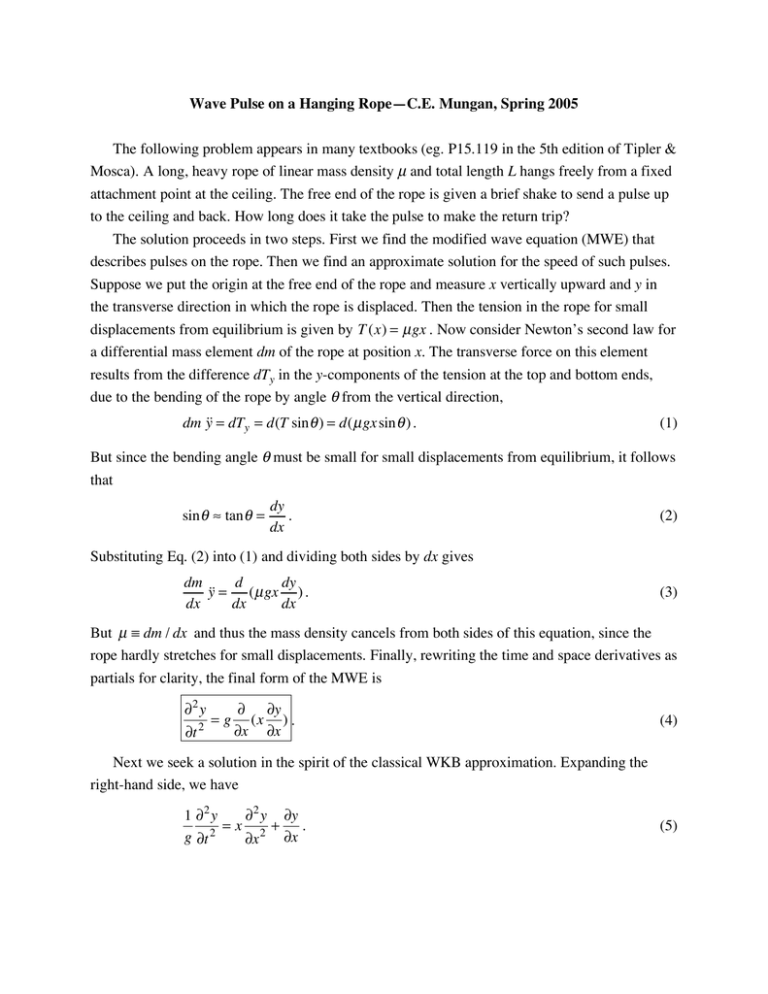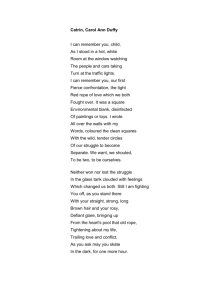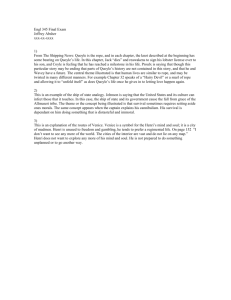Wave Pulse on a Hanging Rope—C.E. Mungan, Spring 2005 L
advertisement

Wave Pulse on a Hanging Rope—C.E. Mungan, Spring 2005 The following problem appears in many textbooks (eg. P15.119 in the 5th edition of Tipler & Mosca). A long, heavy rope of linear mass density µ and total length L hangs freely from a fixed attachment point at the ceiling. The free end of the rope is given a brief shake to send a pulse up to the ceiling and back. How long does it take the pulse to make the return trip? The solution proceeds in two steps. First we find the modified wave equation (MWE) that describes pulses on the rope. Then we find an approximate solution for the speed of such pulses. Suppose we put the origin at the free end of the rope and measure x vertically upward and y in the transverse direction in which the rope is displaced. Then the tension in the rope for small displacements from equilibrium is given by T (x) = µ gx . Now consider Newton’s second law for a differential mass element dm of the rope at position x. The transverse force on this element results from the difference dTy in the y-components of the tension at the top and bottom ends, due to the bending of the rope by angle θ from the vertical direction, dm !! y = dTy = d(T sin ! ) = d( µ gx sin ! ) . (1) But since the bending angle θ must be small for small displacements from equilibrium, it follows that sin ! " tan ! = dy . dx (2) Substituting Eq. (2) into (1) and dividing both sides by dx gives dm d dy !! y = ( µ gx ) . dx dx dx (3) But µ ! dm / dx and thus the mass density cancels from both sides of this equation, since the rope hardly stretches for small displacements. Finally, rewriting the time and space derivatives as partials for clarity, the final form of the MWE is !2 y !t 2 =g ! !y (x ) . !x !x (4) Next we seek a solution in the spirit of the classical WKB approximation. Expanding the right-hand side, we have 1 !2 y !2 y !y = x + . g !t 2 !x 2 !x (5) Since the shake was brief, we assume that the overall vertical length h of the pulse is small. (Or if the rope is shaken back and forth repetitively, we assume the wavelength λ of the resulting wave is small.) In that case, the slope of the rope varies on this length scale, that is !2 y !x 2 " (!y / !x)max h (6) assuming the pulse has an approximately constant curvature. If we substitute Eq. (6) into (5), we see that the second term on the right-hand side of Eq. (5) is negligible compared to the first term once we are more than a few pulse lengths (or wavelengths) away from the free end of the rope ( x >> h ). That is, for most of the pulse’s journey up and down the rope, the MWE can be approximated as !2 y !t 2 " gx !2 y !x 2 . (7) But this has the form of the usual wave equation where the wave speed ! = gx slowly varies along most of the length of the rope. (Note that this is consistent with the usual formula T / µ for a wave on a string.) Compare this to the speed of a ball dropped a distance x from rest, ! ball = 2gx . We thereby see that the pulse has a constant upward acceleration of g / 2 during its travel on the rope. So the time τ that it takes to go up and down the rope of length L is found from L= 1 (g / 2)(! / 2)2 2 " !=4 L . g (8) For further reading 1. There is a nice discussion of the hanging cable and the classical WKB approximation on the web at http://webpages.ursinus.edu/lriley/courses/p212/lectures/node13.html. 2. Experimental confirmation of Eq. (8) is reported in J. Satterly, “Some experiments in dynamics, chiefly on vibrations,” Am. J. Phys. 18, 405 (1950). 3. If we seek standing waves rather than traveling waves on the rope, then Eq. (5) can be solved by separation of variables by seeking a solution of the form y(x,t) = f (x)cos(! t " # ) . If the spatial equation is rewritten in terms of the variable u ! 2" x / g , then one obtains Bessel’s equation of order zero, u 2 f !!(u) + uf !(u) + u 2 f (u) = 0 . (9) The solutions of the first kind are finite at the origin. Imposing the boundary condition that y(L,t) = 0 , gives solutions in terms of the roots of the Bessel function. Photographs of the first three modes are shown in R.E. Gibbs, “Standing waves on a hanging rope,” Phys. Teach. 36, 108 (1998). 4. John Denker has written a perl program to simulate the propagation of an initially square pulse up and down a hanging rope. The code and a 200-frame gif movie can be found at http://www.av8n.com/physics/rope/.







